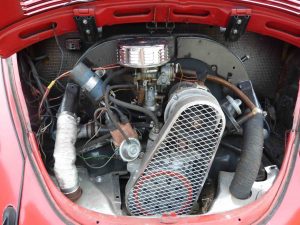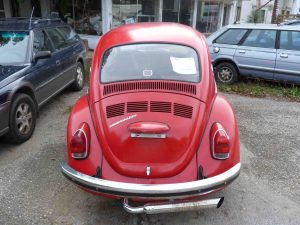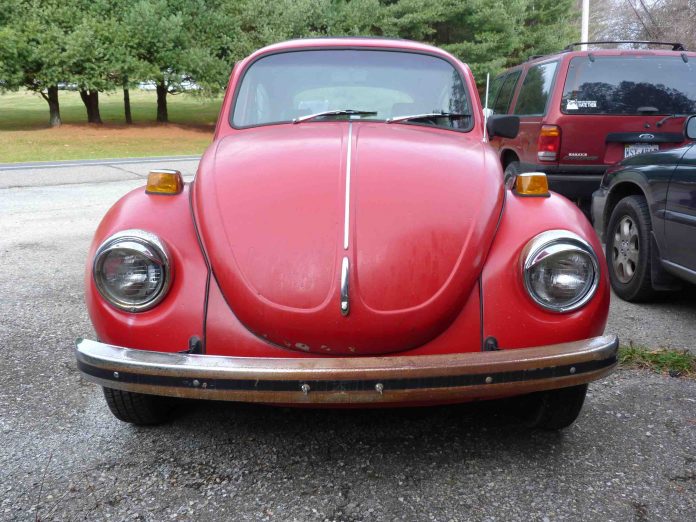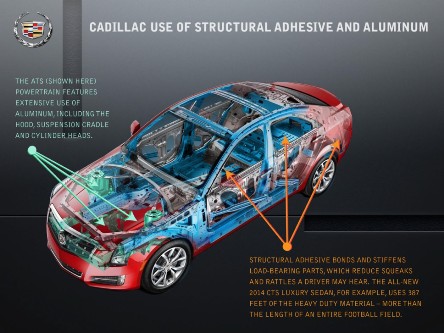Not every kid wants an Uber.
Some kids – one kid, at least – wants a 1972 VW Beetle. And now he has one. This is my young apprentice, Gage. He is going on 16 in a few months and needs wheels. Most uncommonly, these days, he wants them. The kid likes cars. He wanted to learn how to drive a manual transmission. Asked me to help him learn.
This made me feel like old Obi Wan in his hut in the desert. One day, Luke shows up . . . and he is interested in learning about the Force.
Possibly, there is hope.

Gage has already nearly mastered the third pedal – even before taking the imbecile “driver’s test” at the government haus where one must supplicate for the Empire’s permission before being allowed to sit behind the wheel and move a lever from Park to Drive.
As everyone knows, these government-mandatory “tests” do not evaluate a candidate’s ability to competently operate a motor vehicle but rather examine his gift for rote regurgitation of various arbitrary rules and codes, a great many of them either fatuous – always drive the speed limit! (you know, like cops do) – or downright dangerous – always come to a complete stop at all Stop signs! – even when it’s blizzarding outside and the sign is at the top of a steep hill and you have cars behind you and if you do stop, you will almost certainly slide down the hill and into those cars behind you.
Teaching kids to drive is considered unimportant – else they would be taught to drive.
Rather than worry about the fraus at the DMV, Gage is learning to becom proficient with a clutch.

Once he is proficient, he will already be a better driver than most people ever become.
Those who can deal with a third pedal are always better drivers. It means their brains can handle multiple tasks, simultaneously, without (once mastered) even thinking about it. As Yoda told Luke: There is no try. Only do – or do not. So it is with driving with stick. If you can, you are automatically an order of magnitude above the average meatsack behind the wheel.
Those who can’t are not unlike a “pilot” who does not grok the function of the rudder.
Competently driving an old car with a manual transmission and without any government mandated “safety” features is further advanced schooling. It is the equivalent of a SEAL course and successful passage engenders in the candidate higher order skills.

If you can competently drive a ’72 Beetle, not only can you drive any car – you can do so safely. A competent driver is the ultimate safety feature.
You’d think this would be important to the fraus – and “moms” – who run the country, but it’s not. They’d rather put the cart solidly in front of the horse and idiot-proof the car rather than take steps to assure there isn’t an idiot behind the wheel.
It is why there is no driver training worth mentioning, except as provided incidentally. A kid is taught all about buckling up instead. And being defensive; i.e., a passive, rule-fixated Clover.
Gage will learn all about skids.
That if he wishes to stop skidding, he will need to lift off the brakes – contrary to all modern teaching – because a 1972 Beetle does not have ABS.

It doesn’t even have discs.
Accordingly, my young apprentice will acquire the habit of maintaining a following distance sufficient to give him space and time enough not just to stop but to ditch, should that become necessary.
Accelerating likewise requires planning. Another lesson he will learn.
The Beetle’s 1500 CC air-cooled flat four engine produces slightly more horsepower than a riding lawn mower’s engine; you learn to syncopate clutch and throttle and choose the right gear for each moment.
Then, execute.
This is actually fun – something increasingly absent from anything modern. The latter overflow with power, which makes them too easy to drive and thus boring unless driven in a manner that is extremely illegal. Hence most people don’t. They plod along, like cattle, one following another. It is not much fun.
Hence all the gadgets – to keep intellectually idled, physically unchallenged drivers distracted.
An old car is the sure cure for the problem of texting and driving. Only an expert driver can manage a 1972 Beetle and a small keyboard at the same time.
The headlights are dim, the cabin is cold and drafty – which is lucky, given the Beetle’s “heating” system, which conduits carbon monoxide and oil fumes into the cabin. The drafts dilute this, so that focus on the task at hand is maintained.
I have explained about keeping an old rag in the glovebox – not to check the oil but to keep the windshield clear enough to sort-of see when it fogs up. He will learn about setting point gap and driving home in second gear when the clutch cable snaps one night – which it will do one night (probably a very cold night).
He will be equipped with a pair of screwdrivers, Philips head and standard, a crescent wrench, slip-joint pliers, some duct tape, RTV and a roll of wire. These are the essential things one needs to keep a Beetle on the road.
I envy him the memories he’s soon to have.
. . .
Got a question about cars – or anything else? Click on the “ask Eric” link and send ’em in!
If you like what you’ve found here, please consider supporting EPautos.
We depend on you to keep the wheels turning!
Our donate button is here.
If you prefer not to use PayPal, our mailing address is:
EPautos
721 Hummingbird Lane SE
Copper Hill, VA 24079
PS: EPautos stickers are free to those who send in $20 or more to support the site. Also, the eBook – free! – is available. Click here. Just enter you email in the box on the top of the main page and we’ll email you a copy instantly!












my teenage son wanted a 70s chevy K-10 stepside 4wd 4 speed
in the 3 years that hes had it, he has swapped in a LS 5.3 including reworking the wiring harness.
lots of other work too, hes working full time as a HVAC tech and attending welding school too.
Excellent, Justin!
This is just one several examples that hope is not lost. One of the great achievements of the system has been to create an impression of inevitability and ubiquity – that “everyone” basically accepts it or even wants it. This defeats the many who do not, by convincing them they are alone and “weird.”
PS: We just tore down the Solex 34 in the Bug; next thing up is to check/adjust the valve clearance and service the transaxle!
When my daughter took “driver’s ed” in North Carolina, the teacher asked her the meaning of the yellow signs with the speed number on them, that are positioned prior to a curve. She responded that they are “a suggestion.” Perfect answer! The teacher was fuming, but had no response. He wanted her to say that they are posting the maximum legal speed, but she was absolutely right, and did not succumb to his trying to invent another traffic law that did not exist.
There are so many lies told to people in drivers’ ed and drivers’ safety classes. It’s another window on to how government behaves on the bigger issues in what tells people.
Jim, 3-4 years ago or so when the patch was booming the farm road to our county road that leads to our driveway had the numbers on the curves go down. I know why, because of the plethora of new drivers of big rigs that had never been down that road. I’ve watched those numbers change over the years and when the road was at its narrowest back in the 50’s 60’s and 70’s the first curve was 45 and the next curve was 45. In the 80’s or so the first curve was widened and the number went to 55 while the second curve remained narrow and tight and stayed at 45.
One day my wife starts in on this and she saying I’d been driving like a mad man my whole life taking these curves much faster than they are marked now. Oh well, she has no memory and that’s about all I can say to her since she thinks the numbers now have always existed. I can’t explain that since I’ve watched them my entire life even before I drove. The first curve is one I commonly took at 80 in a pickup and faster in better handling vehicles. The last time I drove the Peterbilt with the Rock trailer I ran around it about 70. The next curve I did the old numbers on, 45, since it was a tight curve with little room although it’s now marked 35, a much safer number for a loaded tanker….but that still doesn’t mean it wasn’t lowered. 45 for the next curve that used to be 55 is a decent number for a loaded big rig and I’ve taken it about that speed countless times in a loaded big rig, even less hauling a dozer and less than that hauling a big trackhoe.
But the fact of the matter is these are suggestions and if I had a wreck on one I’d never admit I was doing 80 since the road is set at 70…..for some reason. Get much further west and farm roads are the same 75 the rest of the roads are. The point I’m making is the numbers change according to who and why they are changing. I have no problem of truck drivers coming up on these curves at 35 and 45 since that’s about right for a loaded truck. There was a time when they weren’t based on trucks and 10 mph more on each was easily done without straining my poor wife who can’t be jostled any longer in a curve…..boohoo.. It “hurts” her to strain….and I don’t even notice it.
Great story.
This kid has no idea he’s about to get something far more valuable than some common college degree.
we have a dirt go kart track at a friends house which has been great for the kids https://www.youtube.com/watch?v=Zcr4dt12x7I&feature=youtu.be
Someday reality may set in and the the idea that electric cars are inevitable goes away.
Keep in mind that when that Caddy Eldorado convertible rolled off the line touted by GM in 1976 as the last convertible to be made, ever, most people didn’t disagree. Thankfully that turned out to not be true (though it was almost ten years before another one was made by a major auto maker). The regs got rolled back, and they will have to be rolled back once again.
I was 12 years old in 1972. Coincidentally that was the year I learned to replace contact points in the distributor of my Mom’s International Scout. I knew they had to have the gap set, but I didn’t know about dwell angle or ignition timing so of course the thing wouldn’t start after I changed them. My Mom had the old Scout towed to the repair garage and had the mechanic at the garage give my a lesson on how to do the job right, which I will never ever forget.
Eric;
Make sure that there is ethanol compatible fuel hoses on that. If it has the original style braided hose on it get rid of it immediately! Get rid of that belt guard also.
I can’t remember what year it was but the old beetles used to have a 6volt system. Things get sparky when you discover that you can’t jump off of a 12volt battery. Plus the clutch was goofy and hinged on the floor and went down at an unnatural angle. Even the grey-market 300HP turbo Porsche 930 of 83 vintage had that. I hated it. 4spd, first topped at 55mph, second topped at 93mph. You could outrun your headlights in seven seconds when you got ready to shift to 3rd.
Good story. Perhaps your young padawan will become part of Albert Nock’s remnant.
Yours is the reasoning why years ago I bought a slant six, four-speed stick shift Volare in good condition at a very good price. Even then it has too much electronic crap on the engine, but cars older than it are either beaten/rusted to death or restored, which means $$$. Unlike many owners, I have no wish to install a 318 or 360 in it and put my little slant out to pasture (as the world’s worst mechanic I doubt I could do it anyway). Simplicity, simplicity, simplicity, as Thoreau said.
We, those of us the “libertarian Luddite” crowd, often forget with old cars the fairly common occurrence of being left on the side of the road, often under the worst sort of conditions, due to some mechanical failure of one sort or another.
I can recall one instance of breaking down on the Cross Bronx Expressway (I-95 section that goes through NYC) late at night, where leaving your vehicle meant it would be stripped to the frame in about, oh, an hour or two. This was in a 1976 Mercury Monarch, the Granada’s “upscale” cousin. Electronic ignition but still had rotor and distributor, which, after a quick check, found that the center coil post on the cap had popped out. Ten minutes of crazy glue and a nylon wire tie and I was back on my way.
So, the initial “oh fuck” was followed by an endorphin rush of “that worked out better than expected”, a good feeling of being able to, without waiting or relying on anybody else, the ability to correctly diagnose a problem, take account of the repair supplies at hand, and determine a course of action to make an effective repair and get back underway and out of a potentially dangerous situation.
Moral of the story is: breakdowns suck, but the ability to repair them provides for a sense of accomplishment that is hard to find elsewhere.
Idiot kids like those portrayed in this pitiful commercial, will never have that feeling:
https://www.youtube.com/watch?v=TmOaERW7hd8
Gage will be one of the few that has that chance.
Good for both of you, well done Obi-Wan
I see lots of broke down vehicles on I70 every day. Most are late models. My guess is most of them are out of fuel, but hot summer afternoons, coming up the hogback out of Morrison to Evergreen nearly every day there’s at least one pulled off with a steam eruption under the hood.
A few years ago a truck hauling scrap metal dumped part of the load on the highway. About 10 vehicles, including my work truck, picked up metal in the tires. I set to work changing the flat, but several people around me just got on their phones and called for help. I was back on the road in about 45 minutes, mostly because I couldn’t get the spare to drop. The other vehicles were stuck until the tow truck showed up. The funny thing was a group of Mexicans were behind me. They worked like a Nascar pit crew and were back on the road in less than 10 minutes. I’ll bet they could have picked up a little lunch money if they would have offered their services to the people calling the auto club for help.
Much like the police, when seconds count, the tow truck is only minutes (or hours) away.
Eric, thanks for being a mentor to this young man. Hope is indeed still alive.
Hi Skunk,
I’m having fun, too!
Hell, it’s my way of projecting contumaciousness into the future… 🙂
I bet you are! I had the chance to influence a couple of young people in that way too, though I’m not as well versed as you, I have shown them a thing or two. At least they know how to change oil, which is more than 90% of today’s public.
Hi Henry,
He’s a good kid; they do exist. Makes me wish I’d had one of my own. Gotta find someone worthy to inherit the Trans Am, after all!
great commentary eric, oh what i wouldn’t give to go back to the days of setting point gap and adjusting the carb. i had a 1966 rambler american. i learned how to work on just about every part of that car. but if i go out to work on my modern gm’s or chrysler products i find many things that i have no idea how to deal with. i remember my buddies dad teaching us to use a matchbook cover in the absence of a feeler gauge to set the points on an ford ltd. 0.17 if i remember correctly. it’s great that you are passing this on to the young man….
Hi Timmy, I once had a 10 year old Rambler Classic 770. Huge steering wheel for a car with power steering. But it had a nice interior lacking in today’s sterile cars.
Hey Eric: Nice ride and good thoughts. My kids too, had to learn stick, and grew up on old cars. The skill of having to nurse an old car home after something fails is indispensable. Also, with my kids driving old cars, they are conditioned to observe for any conditions that might reflect vehicle safety or imminent repairs. They’ve changed oil a few times, know how to change a tire, etc. They LOL at a currently-airing car insurance commercial whereby the mother character is saying how the ins co came to help her *son* when he got a flat tire… Other things, my kids drove our big Econoline van, and my S-10 5-spd, so they can basically drive anything. Driving oddball vehicles like that teaches a lot of skills that you just wont get when driving regular, nice cars. Enjoy your site.
This has probably been said before but the end result of all this idiot-proofing is the creation of more (idiotic) idiots.
Wow! Thanks for the memories, Eric. Bought my first new car in 1972…a Super Beetle. I had just joined the Air Force to avoid the draft because I couldn’t afford college. Couldn’t afford any other new car and I didn’t want to buy someone else’s problems. In the ensuing eight years I drove it coast-to-coast 3 times. Put 120,000 miles on it. Much of it in New England winters. Yes, the ice scraper was for the INSIDE of the windshield!
Did my own maintenance. Which is why it swallowed a valve and destroyed the crankcase when I got lax in keeping the valves adjusted. Then a friend with a garage and I swapped the engine for a rebuilt one and I was on the road again after about 4 hours and $600 (if I remember correctly). Try that with today’s excuse for an automobile!
Hi Rod,
So many of us have Beetle Memories… this kid will soon have his own!
I recall a friend buying a Super Beetle and the heater worked like a regular car for the most part.
Speaking of fog on the inside windows the wife was cleaning the truck glass one day and asked if I had read the directions. Not likely since I only read directions as a last resort. So she reads off this Windex foam can that spraying it on a surface and letting it dry stopped moisture from forming. It was the precursor to electrically heated mirrors.
After that someone would see one of us spray Windex on a surface and walk away would ask about it. We’d show them the directions. Dangdest things what a person can learn from reading directions.
Now I read directions on something before I buy it. I don’t want to be obligated to do some things.